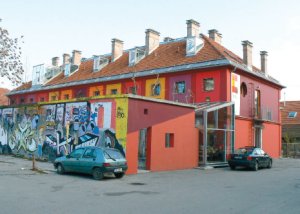Paul Bogen identifies a range of non-arts activities that building-based arts organisations in Europe are using to increase their income.

The two things that managers of arts buildings can usually be certain of are that their running costs will always go up and that their income cannot be guaranteed. Increasing the number of income streams mitigates the risk associated with any single source performing below expectations, by spreading the risk more widely. Five income sources each producing 20% of total income are clearly preferable to two sources each producing 50%. Income streams from non-arts activities can form part of an organisation’s financial strategy, providing it with a wider income base, greater independence and increased stability. But what are these non-arts activities? Can and do they make money, and what are their pros and cons? For the purposes of this article, ‘non-arts activities for buildings’ are defined as those which do not form part of artistic policy, are not directly subsidised by public grants and are intended to produce additional income.
A bewildering variety
Catering, conferencing, retail, rental of space and private hiring are the most common of these activities in building-based organisations. Across Europe, other examples can be found. Metelkova in Ljubljana is based in a former Yugoslavian army barracks, where local artists were commissioned to convert each of the former prison’s twenty cells into a bedroom, creating Hostel Celica. This popular budget accommodation option for tourists was rated the ‘hippest hostel in the world’ by Lonely Planet. Not only does it make money, it is also an effective marketing tool attracting many visitors to the centre.
Ufa Fabrik in Berlin, based on the site of the old UFA film studios, has its own organic bakery, which makes a small annual profit. It also produces all its own water, electricity and heat. Excess electricity is sold back to the power grid, eliminating utility costs and creating an extra source of income. At Korjaamo cultural factory in Helsinki, 50 office workplaces are rented out, making a net profit and producing 20% of its income. The WUK in Vienna has a bicycle repair shop; Stanica in Slovakia is also the local railway station (its web site displays the train timetable) and Farnham Maltings owns a large car park which produces a healthy income with minimal outlay.
Food operations can make but also lose money. Restaurants have the highest bankruptcy rates of all businesses, and catering operations in arts buildings are not immune from this risk. The Belfast Waterfront has a capacity of 2,600, welcomes 500,000 visitors a year and has an excellent brasserie. But even with its central location, its food operation does well in covering its costs. Selling drinks makes more money and is less of a risk than selling food. A well-managed bar operation should be making a net profit after all commercial costs of at least 35% of net turnover. If an arts building is operating a bar and losing money, then, unless there are very low visitor numbers, it probably needs to start worrying. What you are selling, to whom you are selling it and how many visitors you receive a year will all affect turnover and profit. The Melkweg in Amsterdam sells over 250,000 tickets a year and takes £3m from its bars, producing a net profit of £1.2m. But its main activity is rock and pop concerts, and audiences for these events will spend four times as much on drinks per head than theatre or dance audiences. Franchising or contracting out catering services is an option worth considering, as managing a catering operation can take up hours of management time. But if a bar operation has a high turnover, it will probably make more money being run in-house.
Business options
Conferencing and private hiring for meetings, training, weddings, parties and product launches can all be a valuable source of income. But they will be competing with a professional industry that includes hotels and conference centres. Experienced management, effective marketing and high service levels are essential to compete and make a profit. In the USA many arts buildings derive a major part of their income from these activities. Headlands Centre for the Arts near San Francisco charges $4,000 to rent for weddings. On its website you will even find an ‘exclusive caterer and ‘preferred vendors list’.
Without high visitor numbers and/or a great location, there is the risk of losing as well as making money from running a book or gift shop. A medium-sized retail outlet in an arts building would require a turnover in excess of £200,000 to deliver a very small profit, once all of its direct and real overhead cost are taken into account. This equates to a sales target of £80 an hour.
A registered charity may have to establish a trading company to operate non-arts activities legally. This company can be wholly owned by the charity and covenant its profits to the charity free of corporation tax. This requires separate accounting, bank accounts, invoicing and stationery. It also makes charity accounts even more complicated to understand (if that were possible!). Establishing a Community Interest Company (www.cicregulator.gov.uk) for trading activities is a new alternative worth considering.
Capital financing for non-arts activities could be sourced as investment or sponsorship from the commercial sector (such as a brewery for a bar), as a loan from a not-for-profit bank (www.charitybank.org), from commercial investors for an equity stake in the activity/company, from a franchisee, from reserves or through unrestricted fundraising. If public investors can be convinced that projected income from non-arts sources are low risk and form a crucial part of the organisation’s revenue financial strategy, they may be more inclined to support capital bids that include facilities for non-arts activities.
What about the art?
But if the majority of management time, buildings spaces and organisational resources end up being spent on non-arts activities, what happens to the art and the artists? There probably is a ‘tipping point’ where arts buildings are perceived to be (and sometimes actually are) spaces in which art becomes the secondary rather than primary activity. The organisation’s profile, customer base, management culture and image can all be adversely affected by this. Public funding bodies want arts organisations to diversify their income sources, but can become concerned if non-arts activities are too dominant. The answer is to find the right balance between arts and non-arts activities, primary and supporting income streams, what is subsidised and what is commercial. Although they can be an essential source of income, non-arts based activities must be (and be seen to be) supportive of and secondary to a building-based organisation’s primary activities, vision and core purpose. If they become the major discussion item at board meetings they probably either have or are about to become the organisation’s main business. This might be the time to revisit the vision and consider if it might have become slightly blurred.
Paul Bogen works as an arts consultant and cultural management trainer in the UK and Europe, specialising in income generation, finance and strategy. e: paul.bogen@btinternet.com




